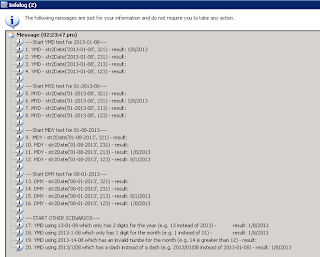From time to time, a user will need to pull a date from a string. More often than not it is from an XML or from some other location. In order to actually use this date passed, it needs to be of data type 'date' so it can be written to fields, used in queries etc. To do this, a user can use the 'str2Date' function.
The str2Date function takes two parameters:
- datestring = The date in string format. It can be separated by either a dash ('-') or slash ('/')
- sequence = A three number combo using 1, 2, and 3 where 1 = day, 2 = month, and 3 = year. (e.g. 231 would be MM-YYY-DD, and 321 would be YYYY-MM-YY)
If the sequence doesn't match the string or has an error, a '0' will result. Note that its very important to distinguish between day and month as an invalid month (>12) will result in a 0 and if both are <13, the date can translate totally wrong.
I've detailed out the results of various scenarios below. Should be pretty self explanatory so I won't go into too much additional detail. I included the output as well as the code used to get it. Kinda neat. Enjoy!

static void date2StringTest(Args _args)
{
str dateStrYMD = '2013-01-08';
str dateStrMYD = '01-2013-08';
str dateStrMDY = '01-08-2013';
str dateStrDMY = '08-01-2013';
str dateStrYMD2y = '13-01-08'; // two digit year
str dateStrYMD1m = '2013-1-08'; // 1 digit month
str dateStrYMDinv = '2013-14-08'; // invalid month
str dateStrYMDslsh = '2013/1/08'; // Slash instead of dash
str zeroResultStr = 'INVALID and will be 0';
int i;
// Note that the second parameter to the str2Date field is 3 numbers which must be a
// combination using 1, 2, and 3 where 1 = day, 2 = month, and 3 = year
// For example 231 would be MM-YYYY-DD, and 321 would be YYYY-MM-YY
// Year Month Day test
info (strFmt("----Start YMD test for %1----", dateStrYMD));
info (strFmt("1. YMD - str2Date('%1', 321) - result: %2", dateStrYMD, str2Date(dateStrYMD, 321)));
info (strFmt("2. YMD - str2Date('%1', 231) - result: %2", dateStrYMD, str2Date(dateStrYMD, 231)));
info (strFmt("3. YMD - str2Date('%1', 213) - result: %2", dateStrYMD, str2Date(dateStrYMD, 213)));
info (strFmt("4. YMD - str2Date('%1', 123) - result: %2", dateStrYMD, str2Date(dateStrYMD, 123)));
info ("");
// Month Year Day test
info (strFmt("----Start MYD test for %1----", dateStrMYD));
info (strFmt("5. MYD - str2Date('%1', 321) - result: %2", dateStrMYD, str2Date(dateStrMYD, 321)));
info (strFmt("6. MYD - str2Date('%1', 231) - result: %2", dateStrMYD, str2Date(dateStrMYD, 231)));
info (strFmt("7. MYD - str2Date('%1', 213) - result: %2", dateStrMYD, str2Date(dateStrMYD, 213)));
info (strFmt("8. MYD - str2Date('%1', 123) - result: %2", dateStrMYD, str2Date(dateStrMYD, 123)));
info ("");
// Month Day Year test
info (strFmt("----Start MDY test for %1----", dateStrMDY));
info (strFmt("9. MDY - str2Date('%1', 321) - result: %2", dateStrMDY, str2Date(dateStrMDY, 321)));
info (strFmt("10. MDY - str2Date('%1', 231) - result: %2", dateStrMDY, str2Date(dateStrMDY, 231)));
info (strFmt("11. MDY - str2Date('%1', 213) - result: %2", dateStrMDY, str2Date(dateStrMDY, 213)));
info (strFmt("12. MDY - str2Date('%1', 123) - result: %2", dateStrMDY, str2Date(dateStrMDY, 123)));
info ("");
// Day Month Year test
info (strFmt("----Start DMY test for %1----", dateStrDMY));
info (strFmt("13. DMY - str2Date('%1', 321) - result: %2", dateStrDMY, str2Date(dateStrDMY, 321)));
info (strFmt("14. DMY - str2Date('%1', 231) - result: %2", dateStrDMY, str2Date(dateStrDMY, 231)));
info (strFmt("15. DMY - str2Date('%1', 213) - result: %2", dateStrDMY, str2Date(dateStrDMY, 213)));
info (strFmt("16. DMY - str2Date('%1', 123) - result: %2", dateStrDMY, str2Date(dateStrDMY, 123)));
info ("");
// Other scenarios
info ("----START OTHER SCENARIOS----");
info (strFmt("17. YMD using %1 which only has 2 digits for the year (e.g. 13 instead of 2013) - result: %2", dateStrYMD2y, str2Date(dateStrYMD2y, 321))); // 2 digit year
info (strFmt("18. YMD using %1 which only has 1 digit for the month (e.g. 1 instead of 01) - result: %2", dateStrYMD1m, str2Date(dateStrYMD1m, 321))); // 1 digit month
info (strFmt("19. YMD using %1 which has an invalid numbe for the month (e.g. 14 is greater than 12) - result: %2", dateStrYMDInv, str2Date(dateStrYMDInv, 321))); // invalid month
info (strFmt("20. YMD using %1 which has a slash instead of a dash (e.g. 2013/01/08 instead of 2013-01-08) - result: %2", dateStrYMDslsh, str2Date(dateStrYMDslsh, 321))); // different divider
}

















